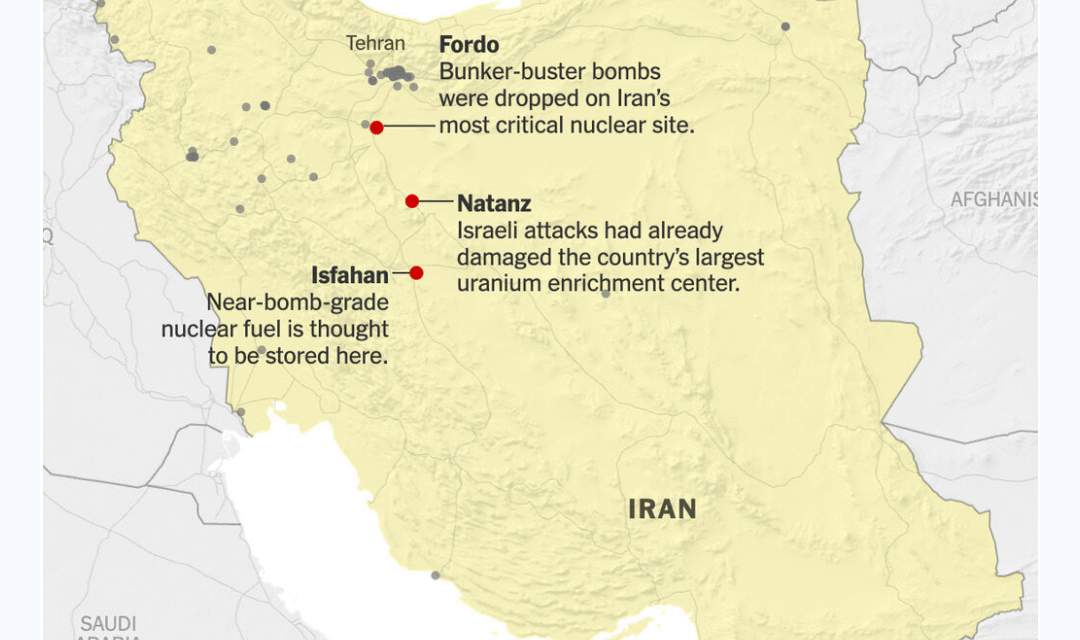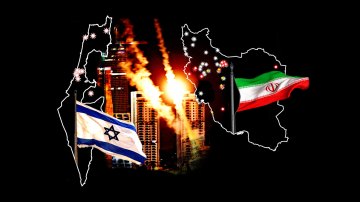Lauren Jackson headshotEvan Gorelick headshot
by Lauren Jackson and Evan Gorelick
Last night, the U.S. entered the war with Iran.
President Trump upended decades of diplomacy when he sent American warplanes and submarines to strike three of Iran’s nuclear facilities — including Fordo, its top-secret site buried deep inside a mountain. The bombs fell at about 2:30 a.m. local time.
In an address from the White House, Trump said the goal of the strikes was to keep Iran from building a nuclear weapon. He claimed the facilities had been “completely and totally obliterated,” but the extent of the damage is not yet clear.
Trump also called for the war to end. “Iran, the bully of the Mideast, must now make peace,” he said. He threatened “far greater” attacks if it did not.
Still, the war continues: Iran said today that it wasn’t open to diplomacy right now. It launched missiles into Israel early this morning, wounding at least 16. Israel responded with its own strikes on Iran. More than 40,000 American troops are stationed in the region, and the U.S. is expecting retaliation. (See American bases that Iran could strike.)
The U.S. attack was an “extraordinary turn for a military that was supposed to be moving on from two decades of forever wars in the Middle East,” our colleagues Helene Cooper, Eric Schmitt and Julian Barnes wrote.
Below, we explain the strikes and what could happen next.
What were the targets?
A map showing, north to south, Fordo, Natanz and Ishafan. They sit in a line between Tehran and central Iran.
The New York Times
America targeted three Iranian sites, including the buried facility at Fordo, the crown jewel in the country’s nuclear program. The U.S. is the only country believed to have bombs big enough to reach it. Israel has been asking Trump to strike the site since its offensive began. Now he has.
Here’s what we know about each target:
Fordo: Iran built this site — where centrifuges concentrate uranium to a form used in nuclear weapons — inside a mountain to shield it from attacks. The U.S. military concluded that one “bunker-buster” bomb would not destroy it. So six B-2 bombers dropped a dozen of these 30,000-pound weapons, a U.S. official said. The attack was the first time the military had used the weapon in combat. See how the powerful bombs work.
Natanz: This is the largest uranium enrichment site in Iran. Its centrifuge halls are also buried deep underground, but experts say this site is less secretive and less heavily fortified. Israel struck the site recently with warplanes; the U.S. struck it with cruise missiles launched from submarines.
Isfahan: The U.S. also hit a site that holds Iran’s largest nuclear fuel stockpiles near the ancient city of Isfahan. Israel hit parts of the facility last week but avoided the fuel.
Why did the U.S. strike?
The U.S. says it is joining Israel in its war to keep Iran from creating a nuclear bomb.
Trump pledged as a presidential candidate to keep America out of “stupid endless wars.” But he also vowed to prevent the Islamic Republic from obtaining a nuclear weapon.
Israel and Iran, sworn enemies for decades, have been striking each other for more than a week. Israelis launched a surprise assault that targeted Iranian infrastructure, including nuclear installations, and military leaders. Israel wanted U.S. help, but Trump was noncommittal.
When Israel began its attacks, the U.S. secretary of state, Marco Rubio, said, “We are not involved in strikes against Iran.” Trump said that he would decide “within the next two weeks” whether to help. He took two days


